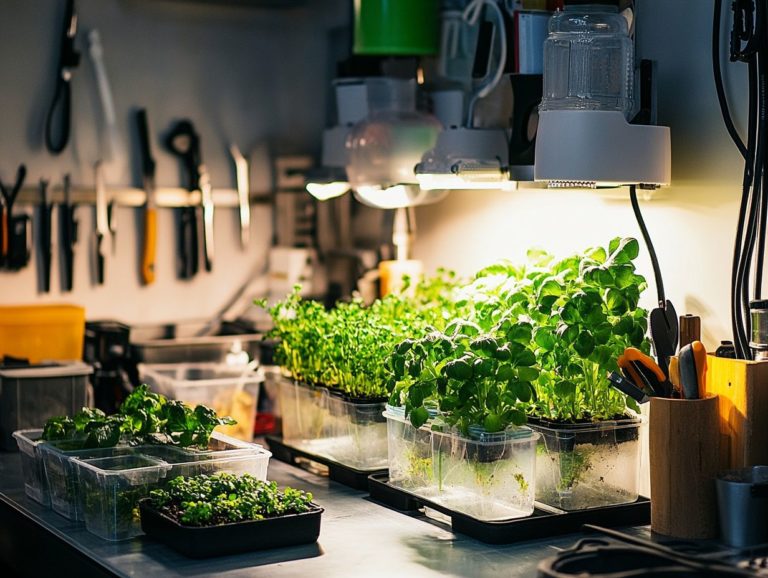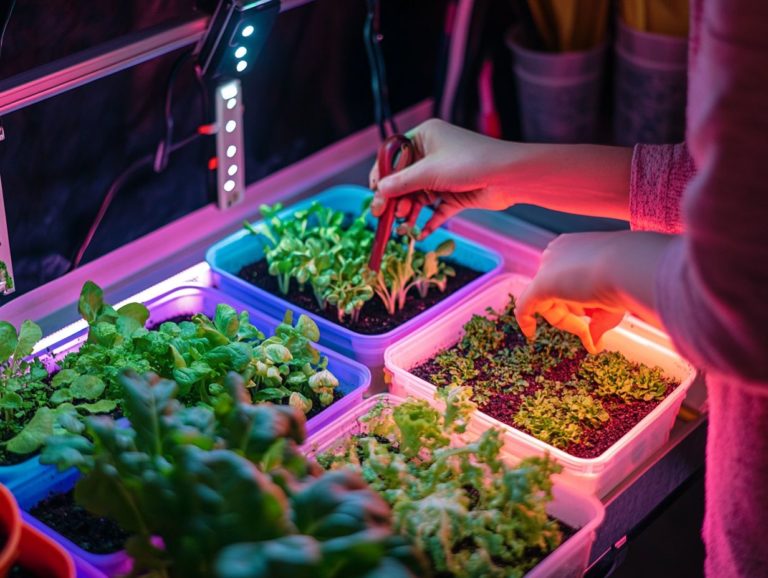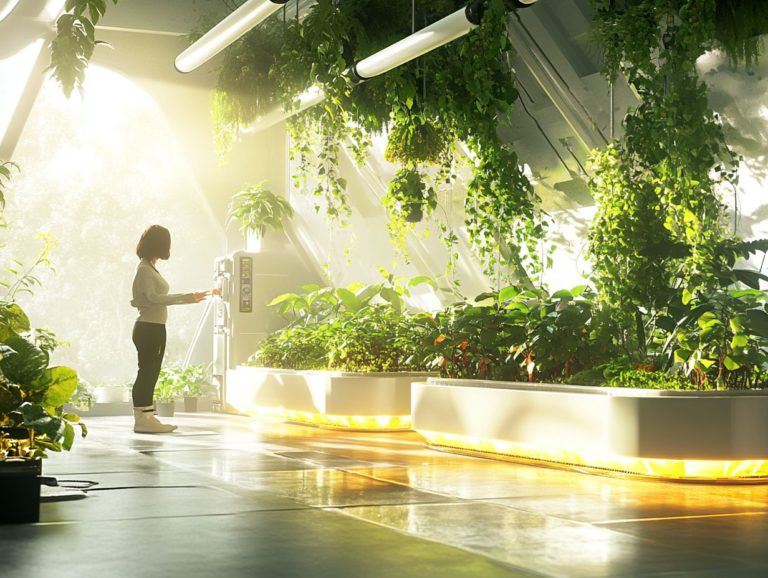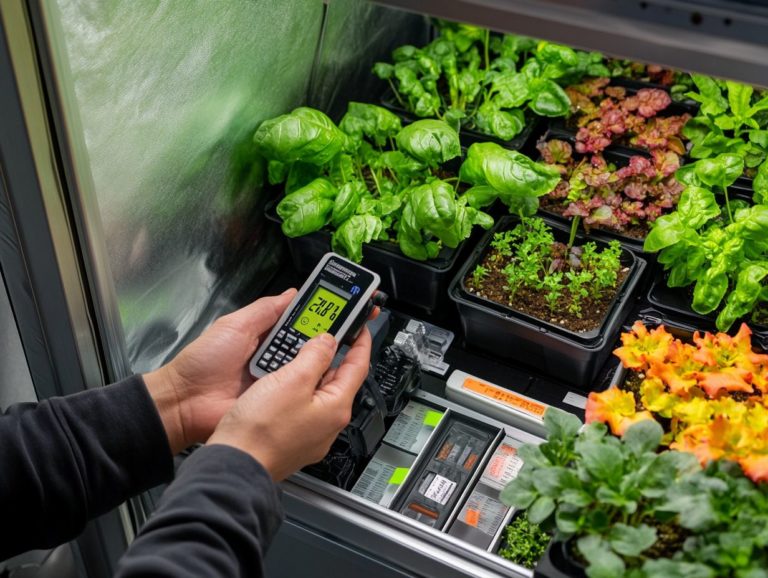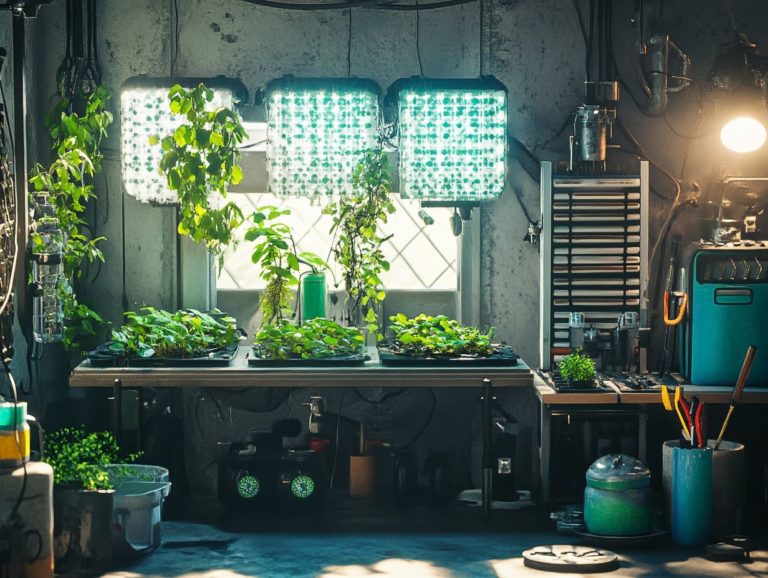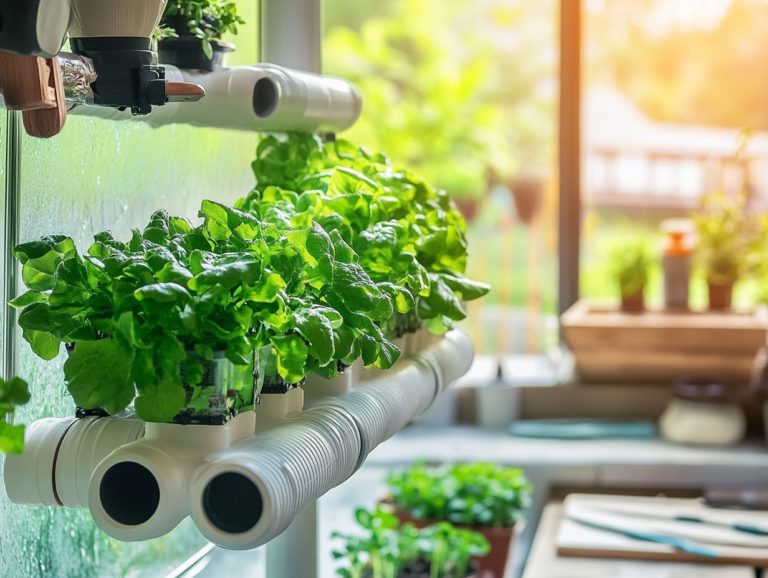Top 10 DIY Hydroponic Projects for Beginners
Hydroponics is revolutionizing the way you grow plants, allowing you to cultivate fresh produce right at home without the need for soil.
Get ready to discover ten DIY hydroponic projects that are ideally suited for beginners!
From straightforward mason jar gardens to sophisticated floating raft systems, you’ll find innovative ideas that cater to any space and budget.
Prepare to roll up your sleeves and transform your indoor space into a thriving garden!
Contents
- Key Takeaways:
- 1. DIY PVC Pipe Hydroponic System
- 2. Mason Jar Hydroponic Herb Garden
- 3. Vertical Hydroponic System Using Plastic Bottles
- 4. Hanging Bucket Hydroponic System
- 5. Window Farm Hydroponic System
- 6. Floating Raft Hydroponic System
- 7. Grow Tower Hydroponic System
- 8. Drip System Using Plastic Containers
- 9. Dutch Bucket Hydroponic System
- 10. Nutrient Film Technique (NFT) Hydroponic System
- What Is Hydroponics and Why Is It Gaining Popularity?
- What Are the Benefits of DIY Hydroponic Systems?
- What Are the Essential Components of a Hydroponic System?
- How Can Beginners Choose the Right Plants for Their Hydroponic System?
- What Are the Common Mistakes to Avoid in DIY Hydroponic Projects?
- What Are Some Creative Ways to Repurpose Materials for Hydroponic Systems?
- Frequently Asked Questions
- What are the top 10 DIY hydroponic projects for beginners?
- What materials do I need for a DIY hydroponic project?
- Do I need any special skills or knowledge to build a DIY hydroponic system?
- How much space do I need for a DIY hydroponic system?
- Are DIY hydroponic projects cost-effective?
- Can I grow any type of plant using a DIY hydroponic system?
Key Takeaways:
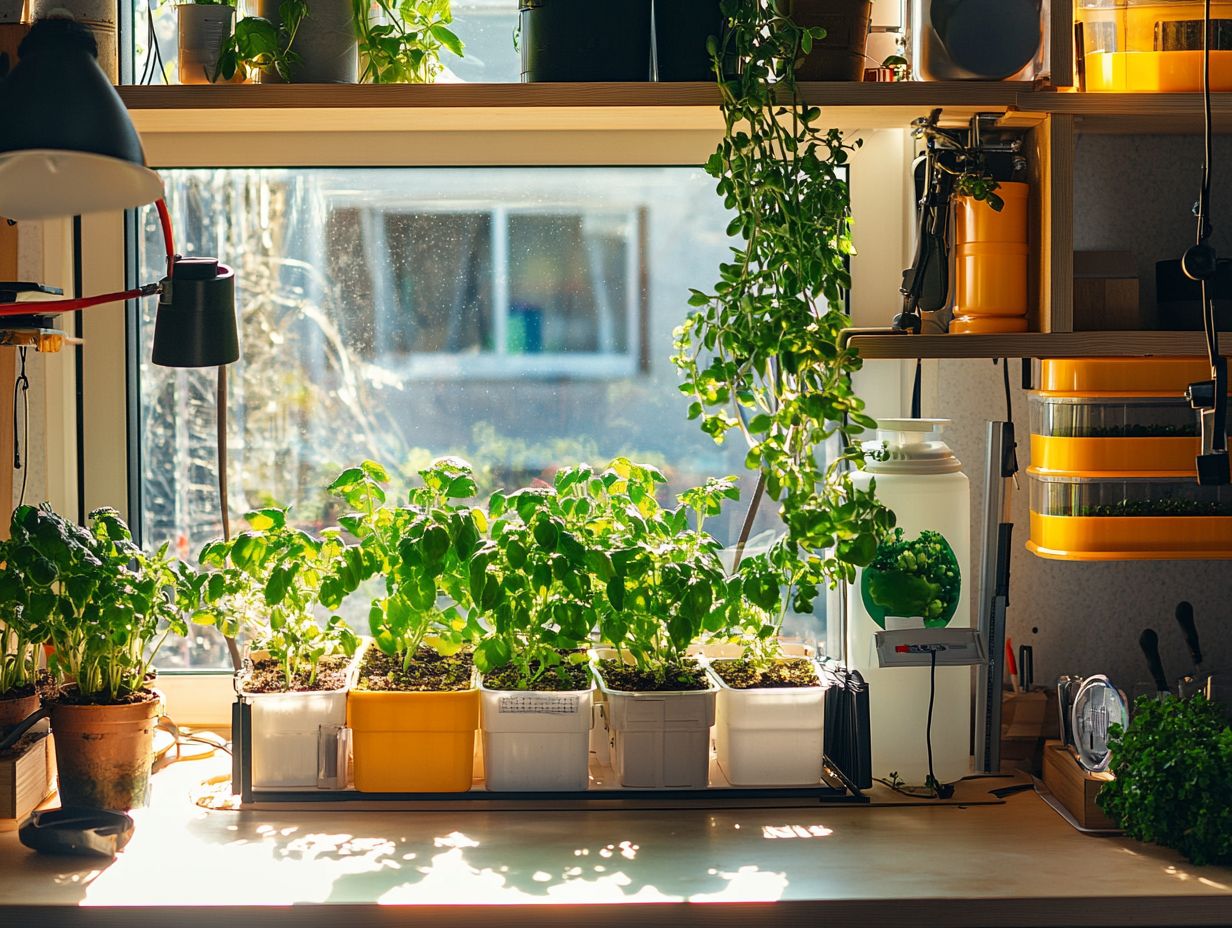
- Growing your own plants through hydroponics is gaining popularity and is easy for beginners to learn and experiment with.
- DIY hydroponic systems can be made from everyday materials such as PVC pipes, mason jars, and food-grade plastic bottles, making it a cost-effective and sustainable option.
- The key components of a hydroponic system include a growing medium, a mix of water and plant nutrients, and a water source, which can all be easily obtained or repurposed.
1. DIY PVC Pipe Hydroponic System
Creating your own DIY PVC pipe hydroponic system offers an exciting and sustainable way to grow a variety of plants indoors. Imagine cultivating fresh organic greens like lettuce and kale all year round, minimizing plastic waste and conserving water.
This compact system can be set up with ease using basic materials and some knowledge about methods for growing plants without soil.
To embark on this rewarding project, you ll need a few essential items:
- PVC pipes
- A reservoir for nutrient solutions
- Net pots
- A water pump
Arranging the pipes at a slight angle allows water to flow efficiently, and strategically placing grow lights ensures your plants receive the ample light they need for optimal growth.
When crafting your nutrient solution, achieving the right balance of water and nutrients is crucial for effective absorption by your plants.
Watch your seedlings for signs of growth; maintaining proper water levels and ensuring a suitable pH will enhance their root development.
By monitoring nutrient uptake and ensuring effective water conservation, you can cultivate thriving vegetables, turning each harvest into a delightful achievement that any gardener would celebrate.
2. Mason Jar Hydroponic Herb Garden
A mason jar hydroponic herb garden offers a stylish and efficient way to cultivate fresh herbs like basil and parsley indoors. With this setup, you’ll have fresh organic greens at your fingertips for your culinary adventures while enhancing your overall gardening experience.
This straightforward setup requires just a few essential components, including air pumps and nutrient solutions that create the perfect balance for rapid plant growth. The air pump works to oxygenate the water, ensuring your plants’ root systems receive the air they need to flourish. Concurrently, nutrient solutions supply vital minerals that traditional soil gardening often lacks.
To maintain optimal growth, it s important to regularly check and adjust water levels, making sure to top them up to prevent drying out. Balancing those nutrient-rich solutions is equally crucial.
With just a little care and attention, you can enjoy the fruits of a thriving indoor garden, showcasing nature’s bounty right on your kitchen counter.
3. Vertical Hydroponic System Using Plastic Bottles
Utilizing vertical farming techniques, a hydroponic system crafted from plastic bottles allows you to maximize space while cultivating a diverse array of vegetables. This highlights the remarkable potential for sustainable farming in urban settings, especially for summer gardening.
By transforming discarded plastic into functional gardening tools, this innovative approach not only reduces waste but also champions an environmentally friendly lifestyle.
Vertical gardening presents a wealth of advantages, including improved air circulation and increased sunlight exposure, both of which contribute to healthier plants and enhanced yields.
Water conservation becomes a central focus, as these systems can employ recirculating pumps to minimize waste. Varieties like tomatoes, lettuce, and herbs flourish particularly well in these setups, enabling you to enjoy fresh produce conveniently right from your home.
4. Hanging Bucket Hydroponic System
A hanging bucket hydroponic system is the perfect solution for those with limited gardening space. It enables you to nurture plants in a compact setup while ensuring ideal growing conditions.
This method supercharges your vertical space, making it ideal for small patios or balconies. It also enhances your accessibility to plants for maintenance and harvesting.
To set up this system, you ll need a few essential materials:
- Durable buckets
- A water mixed with nutrients plants need to grow
- A pump for circulation
- A reservoir
- Sturdy hanging hardware
Regularly monitoring pH (a measure of acidity or alkalinity) and nutrient levels is crucial for maintaining optimal plant health. Proper air circulation around the buckets promotes robust root development, vital for your plants’ vitality.
5. Window Farm Hydroponic System
Creating a window farm hydroponic system will transform your window space into a vibrant green oasis. You’ll be able to cultivate fresh herbs and vegetables indoors. This setup not only makes the most of natural light but also reduces your reliance on store-bought produce.
To truly maximize the benefits of your indoor garden, it’s essential to optimize light exposure. Ensure your plants receive ample sunlight throughout the day. If natural light falls short, incorporating grow lights can significantly enhance their growth and vitality.
Proper plant care techniques are key to your success. By monitoring nutrient solutions and adjusting them according to the specific needs of each plant, you’ll establish a solid foundation for a flourishing garden. Mastering effective watering techniques is crucial; maintaining the right moisture levels without over-saturating the roots creates a thriving environment for your green companions.
6. Floating Raft Hydroponic System
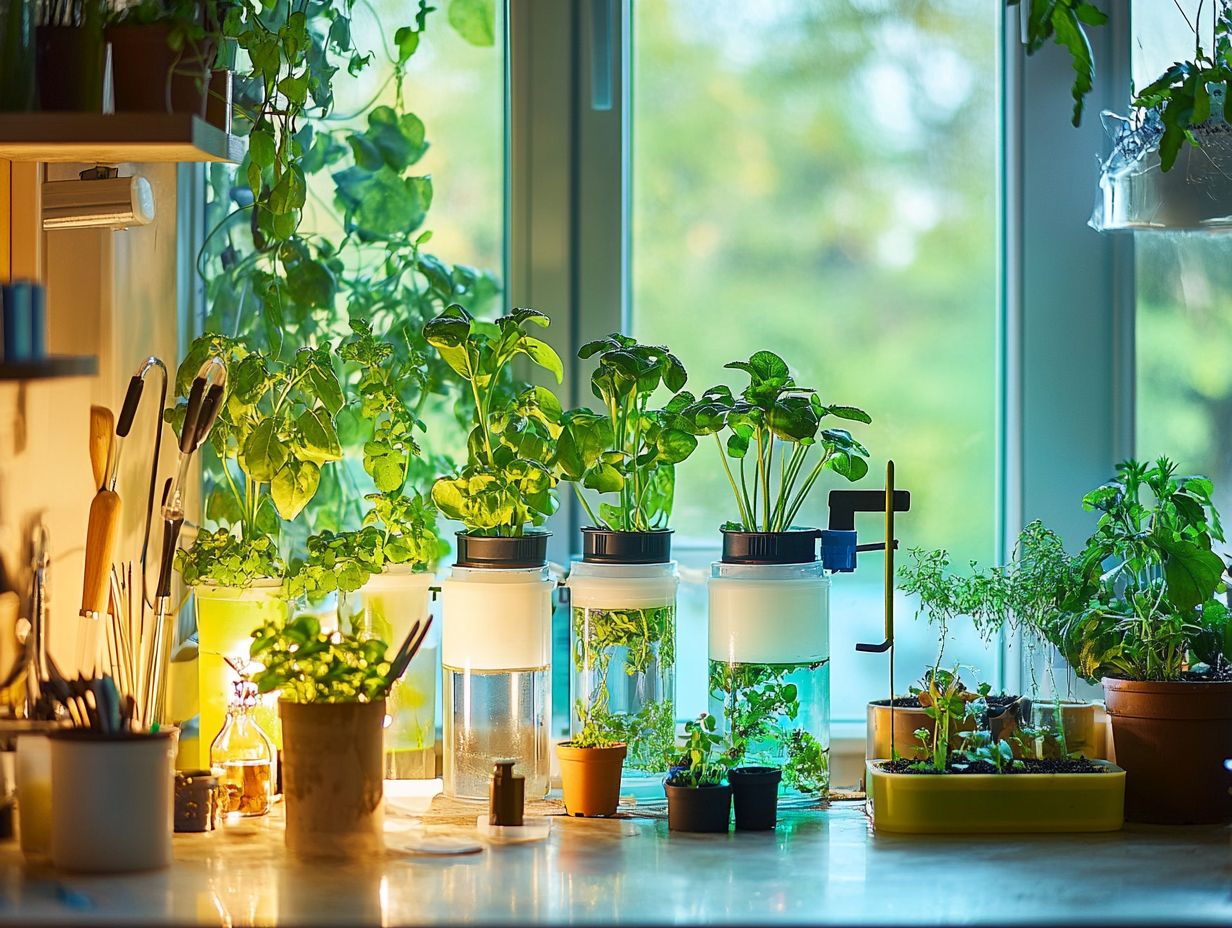
The floating raft hydroponic system offers you an efficient method for cultivating crops like lettuce, allowing plants to flourish on a buoyant raft that floats atop a nutrient-rich water reservoir. This setup ensures optimal growth and nutrient uptake for your lettuce.
This innovative approach allows you to maximize space usage, making it particularly suited for urban environments where land is scarce. In this system, the roots dangle freely in the water, granting direct access to a perfectly balanced mix of nutrients while the raft provides the necessary support and stability, along with ample sunlight exposure.
Maintaining water quality is vital for your success. Regularly monitoring pH and nutrient levels can help you prevent crop diseases and encourage vigorous growth. This method not only offers higher production rates compared to traditional farming but also benefits you with a consistent harvest and enhanced resource efficiency.
7. Grow Tower Hydroponic System
A grow tower hydroponic system is the pinnacle of vertical farming, enabling you to cultivate a variety of plants within a compact, space-efficient structure while ensuring they receive ample light and nutrients. It’s ideal for your homegrown organic greens and a great addition to your gardening experience.
In this setup, planting seeds is both straightforward and efficient. The arrangement facilitates optimal spacing, guaranteeing that each plant gets just the right amount of sunlight and air circulation. By utilizing vertical space, you not only maximize your floor area but also encourage faster growth, as plants thrive in well-lit conditions.
Keep your plants thriving and vibrant by regularly checking water levels, nutrient concentrations, and pH balance. Using natural pest deterrents and ensuring adequate airflow can significantly boost overall vitality, allowing you to enjoy a generous harvest of fresh produce no extensive gardening experience required.
8. Drip System Using Plastic Containers
Implementing a drip system with plastic containers gives you precise control over nutrient delivery. This allows for optimal water conservation and nutrient uptake while promoting healthy growth in your hydroponic garden, making it suitable for family gardening.
By thoughtfully arranging the containers, you can minimize space and maximize sunlight exposure. Each container should have a drip emitter, a device that releases water slowly, delivering nutrient-rich water directly to the roots and significantly reducing waste.
Air pumps maintain proper aeration, ensuring your nutrient solution stays well-oxygenated. Regularly monitor the nutrient solutions to maintain the right pH and nutrient levels, preventing deficiencies that could impede your plants’ development and yield.
With this approach, you re setting your garden up for success!
9. Dutch Bucket Hydroponic System
The Dutch bucket hydroponic system allows you to cultivate larger plants in individual buckets filled with nutrient-rich solutions. This system also facilitates effective water management.
This clever setup features a series of connected buckets, each dedicated to its own plant, capable of draining excess water back to a central reservoir. The design optimizes space and ensures each plant receives a tailored supply of nutrients and moisture.
Various seed varieties benefit from this approach, as it enables you to customize nutrient management and create optimal growing conditions. Monitor nutrient levels closely to boost yield and enhance plant health.
10. Nutrient Film Technique (NFT) Hydroponic System
The Nutrient Film Technique (NFT) hydroponic system is your gateway to efficient lettuce growth and growing herbs. This method allows a delicate film of nutrient solution to flow over the roots, providing essential nutrients while significantly reducing water usage.
This approach optimizes the growing process and plays a vital role in sustainable agriculture. By delivering the perfect amount of nutrients without the excess runoff common in traditional farming, NFT systems greatly enhance water conservation efforts.
Setting up your NFT hydroponic system requires meticulous attention to detail in configuring channels the pathways where nutrients flow pumps, and nutrient balances. When done correctly, you can achieve outstanding results.
Ultimately, this method enables you as a homegrown produce enthusiast to maximize your yield while efficiently using water and nutrients, making it an appealing choice for eco-conscious gardeners.
What Is Hydroponics and Why Is It Gaining Popularity?
Hydroponics is a groundbreaking approach to cultivating plants without soil. This method employs nutrient solutions delivered directly to the roots, rapidly becoming popular because it saves water and space perfect for urban living!
The roots of this technique stretch back to ancient civilizations that experimented with soilless cultivation. Recently, hydroponics has experienced a renaissance, driven by rising concerns about food security and challenges posed by a growing global population.
As urban areas expand, the demand for efficient farming solutions that thrive in confined spaces becomes increasingly urgent. Hydroponics not only conserves water but also significantly reduces land usage, addressing critical issues of food scarcity and environmental sustainability.
As awareness of ecological footprints grows, this method emerges as a compelling alternative for cultivating fresh produce within city limits. It is fundamentally reshaping how communities engage in urban gardening.
What Are the Benefits of DIY Hydroponic Systems?
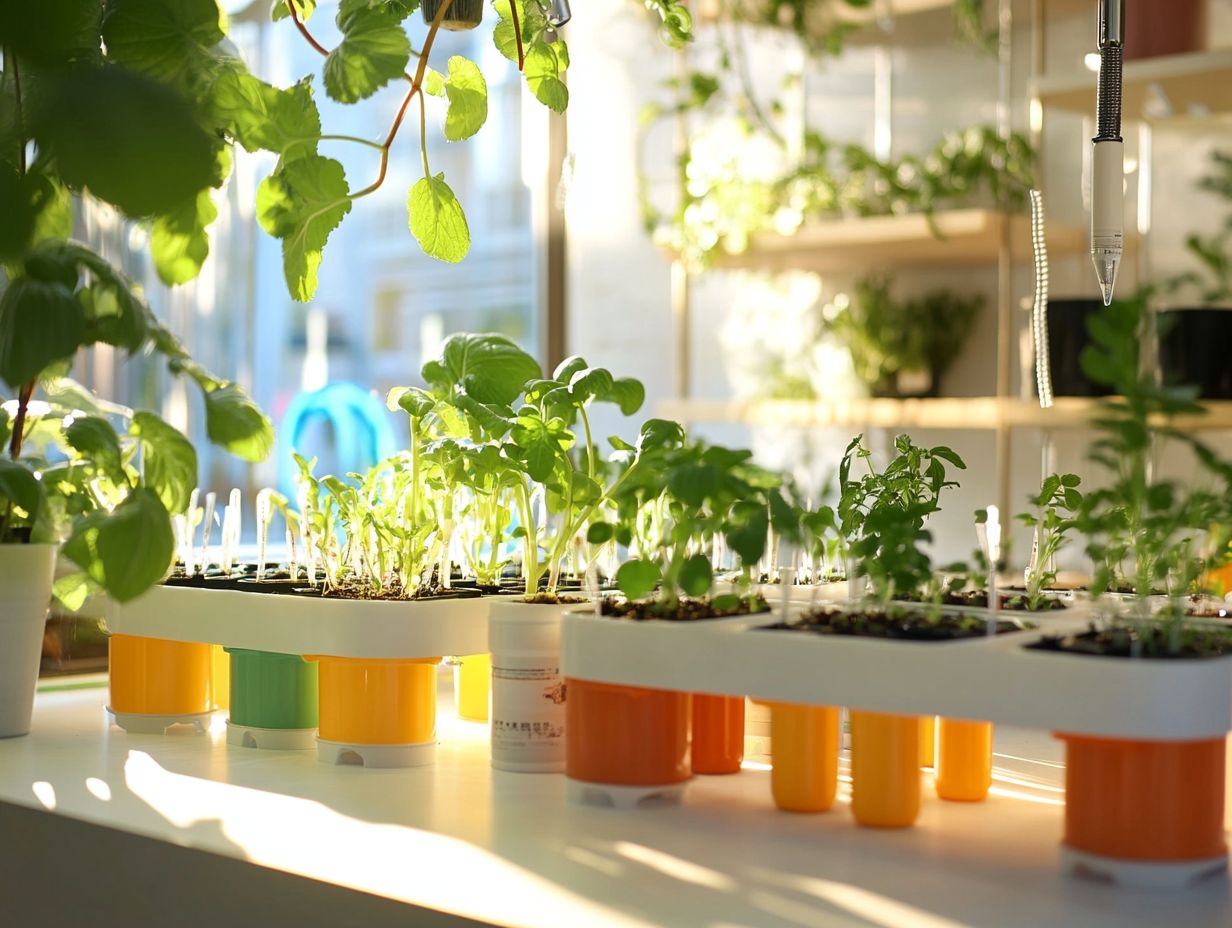
DIY hydroponic systems present a multitude of advantages, allowing you to create nutrient-rich solutions finely tuned to the specific needs of your plants. They enhance your water conservation efforts and offer the rewarding experience of growing your own fresh produce right at home.
These systems are budget-friendly, allowing you to garden without spending a fortune while maximizing your yields. Customization stands out as another remarkable benefit; you can adjust your setup to accommodate a variety of plant species, from leafy greens like lettuce and spinach to vibrant flowering plants such as tomatoes and peppers. For those new to the practice, understanding what is the best hydroponic setup for beginners can provide valuable insights. This level of flexibility not only boosts plant growth but also allows you to garden year-round, regardless of the whims of the weather outside.
You can enjoy the joy of harvesting fresh produce throughout the year while also minimizing your carbon footprint. It’s satisfying to cultivate your own food.
What Are the Essential Components of a Hydroponic System?
A successful hydroponic system hinges on several critical components. You need a well-structured water reservoir, a nutrient solution to nourish your plants, and systems like air pumps to provide the essential oxygenation for optimal growth.
Including grow lights can be a game changer, particularly in environments that lack natural sunlight. Your choice of grow media, whether it s rock wool or clay pellets, is crucial as it anchors the plants while retaining moisture without risking waterlogging.
The type of hydroponic setup you choose be it nutrient film technique, which is a method where a thin film of nutrient solution flows over the plant roots, or deep water culture, which involves suspending plants in a nutrient-rich solution will often depend on the specific plants you re cultivating. Each species has unique root structures and growth needs.
When all these elements work together, they create a harmonious environment, ensuring your plants receive everything they need to thrive. This ultimately maximizes yield and health.
How Can Beginners Choose the Right Plants for Their Hydroponic System?
Choosing the right plants is crucial for you as a beginner starting your hydroponic project. Certain plant varieties, such as herbs and lettuce, flourish in this unique environment, so it s essential to grasp the optimal conditions for nurturing seedlings and fostering growth.
For those just starting out, leafy greens like lettuce are among the best choices. They grow quickly and require minimal space. Don’t overlook herbs like basil and mint, either; they not only enhance your culinary creations but also thrive in nutrient-rich water. To get the best results, consider using the top 5 hydroponic fertilizers for beginners.
As you dive into this venture, take the time to assess the specific needs of your chosen varieties. Research factors such as light requirements, nutrient needs, and pH levels to ensure you provide the proper care throughout their growth stages. Regularly monitoring growth conditions and making timely adjustments can truly elevate your hydroponic gardening experience. For beginners, exploring the top hydroponic growing systems can lead you to a rewarding and fruitful outcome.
What Are the Common Mistakes to Avoid in DIY Hydroponic Projects?
Avoid these common pitfalls! They can sabotage your gardening success, especially during winter. DIY hydroponics can be incredibly rewarding, but it’s easy to trip over mistakes that many beginners make, like getting the ratios of nutrient solutions wrong, skimping on light, or neglecting plant care.
Master the basics of managing nutrients to thrive in hydroponic gardening, as plants have specific needs to flourish. Insufficient light can result in weak growth and lackluster yields, so it s essential to select the right lighting fixtures and maintain appropriate light cycles.
Keeping an eye on environmental factors like temperature and humidity is also crucial for creating a stable growing environment. By steering clear of these frequent pitfalls and putting effective strategies into practice, you can elevate your hydroponic experience and cultivate healthy, thriving plants.
Start your hydroponic adventure today and enjoy fresh, homegrown produce all year round!
What Are Some Creative Ways to Repurpose Materials for Hydroponic Systems?
Repurposing materials for hydroponic systems is a brilliant way to embrace sustainable farming practices. You can cut down on plastic waste while engaging in functional DIY projects that promote environmental awareness.
By transforming everyday items into effective growing systems, you can play a vital role in helping the environment and reduce your carbon footprint. For example, those old plastic containers sitting in your cupboard can be quickly turned into planters for your favorite herbs and veggies!
When you cut and assemble PVC pipes just right, they can create an efficient vertical garden. This is perfect for making the most of limited space. For those looking to optimize their small areas, consider exploring the top hydroponic systems for small spaces. Using household items like shelves and old light fixtures not only sparks your creativity but also offers a unique and rewarding planting experience.
This resourcefulness supports a greener planet and cultivates a vibrant gardening culture. It encourages others to engage in family gardening and summer gardening activities.
Frequently Asked Questions
Curious about getting started with hydroponics? Here are some common questions beginners ask!
What are the top 10 DIY hydroponic projects for beginners?
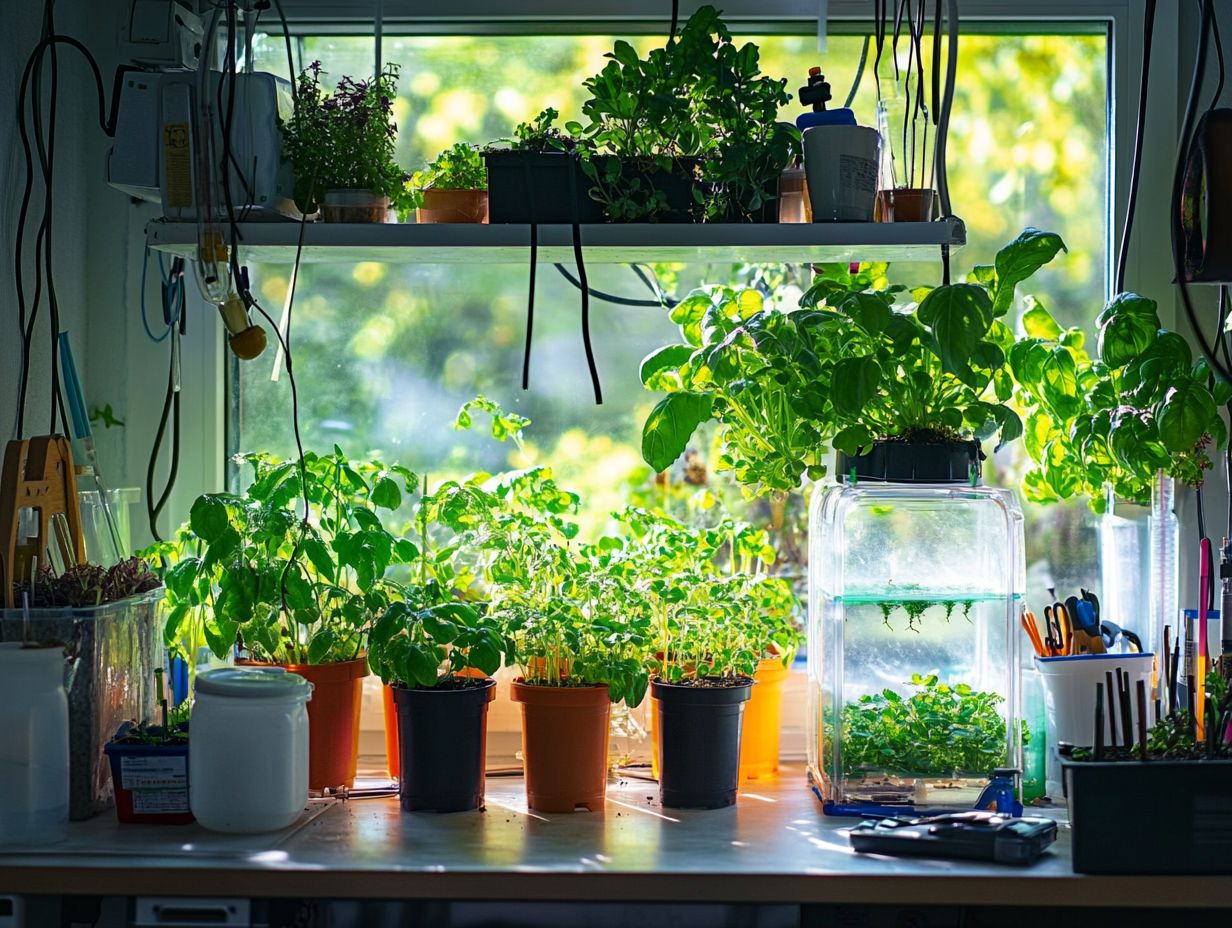
The top 10 DIY hydroponic projects for beginners include: mason jar herb garden, PVC pipe vertical garden, soda bottle hydroponic system, floating raft system, wick system, drip system, ebb and flow system, kratky method, aeroponic system, and deep water culture system.
What materials do I need for a DIY hydroponic project?
The materials needed will vary depending on the specific project. Common supplies include a container, growing medium, plant nutrients, water pump, tubing, and a light source.
Do I need any special skills or knowledge to build a DIY hydroponic system?
No, most DIY hydroponic projects are designed for beginners and do not require any special skills or knowledge. However, it’s important to follow instructions carefully and do some research on hydroponic gardening before starting.
How much space do I need for a DIY hydroponic system?
The amount of space needed will depend on the specific project. Most DIY hydroponic systems are compact and can easily fit on a windowsill or countertop. Some larger systems may require a small dedicated space.
Are DIY hydroponic projects cost-effective?
Yes, DIY hydroponic projects can be cost-effective in the long run. They eliminate the need for soil and can be built using inexpensive materials. Plus, you can grow your own fresh produce at a fraction of the cost of buying it in stores.
Can I grow any type of plant using a DIY hydroponic system?
Yes, you can grow a variety of plants using a DIY hydroponic system, including vegetables, herbs, and even some fruits. However, some plants may require specific nutrients or growing conditions, so it’s important to do some research on the specific plant before starting your project.

